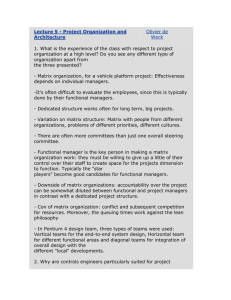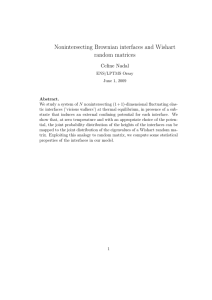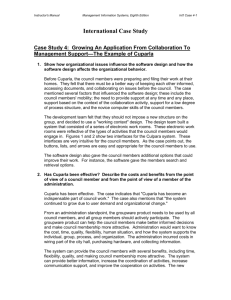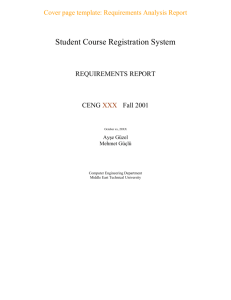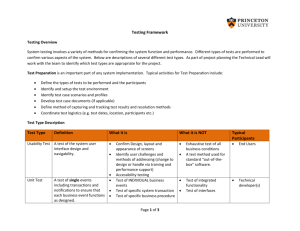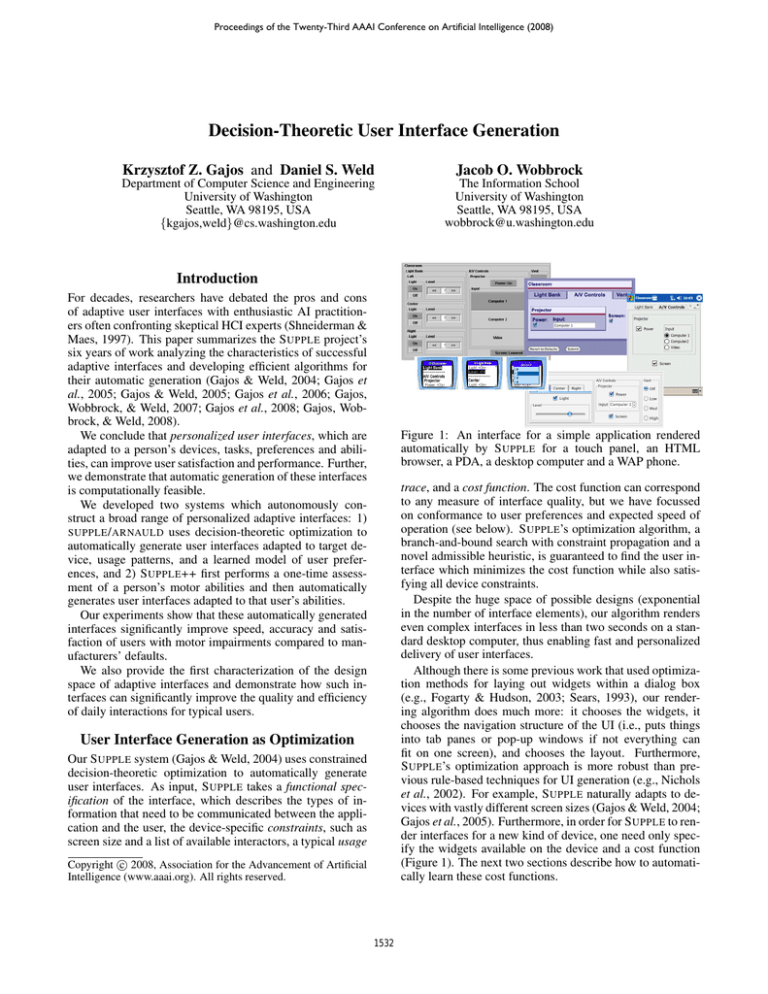
Proceedings of the Twenty-Third AAAI Conference on Artificial Intelligence (2008)
Decision-Theoretic User Interface Generation
Krzysztof Z. Gajos and Daniel S. Weld
Jacob O. Wobbrock
Department of Computer Science and Engineering
University of Washington
Seattle, WA 98195, USA
{kgajos,weld}@cs.washington.edu
The Information School
University of Washington
Seattle, WA 98195, USA
wobbrock@u.washington.edu
Introduction
For decades, researchers have debated the pros and cons
of adaptive user interfaces with enthusiastic AI practitioners often confronting skeptical HCI experts (Shneiderman &
Maes, 1997). This paper summarizes the S UPPLE project’s
six years of work analyzing the characteristics of successful
adaptive interfaces and developing efficient algorithms for
their automatic generation (Gajos & Weld, 2004; Gajos et
al., 2005; Gajos & Weld, 2005; Gajos et al., 2006; Gajos,
Wobbrock, & Weld, 2007; Gajos et al., 2008; Gajos, Wobbrock, & Weld, 2008).
We conclude that personalized user interfaces, which are
adapted to a person’s devices, tasks, preferences and abilities, can improve user satisfaction and performance. Further,
we demonstrate that automatic generation of these interfaces
is computationally feasible.
We developed two systems which autonomously construct a broad range of personalized adaptive interfaces: 1)
SUPPLE / ARNAULD uses decision-theoretic optimization to
automatically generate user interfaces adapted to target device, usage patterns, and a learned model of user preferences, and 2) S UPPLE ++ first performs a one-time assessment of a person’s motor abilities and then automatically
generates user interfaces adapted to that user’s abilities.
Our experiments show that these automatically generated
interfaces significantly improve speed, accuracy and satisfaction of users with motor impairments compared to manufacturers’ defaults.
We also provide the first characterization of the design
space of adaptive interfaces and demonstrate how such interfaces can significantly improve the quality and efficiency
of daily interactions for typical users.
Figure 1: An interface for a simple application rendered
automatically by S UPPLE for a touch panel, an HTML
browser, a PDA, a desktop computer and a WAP phone.
trace, and a cost function. The cost function can correspond
to any measure of interface quality, but we have focussed
on conformance to user preferences and expected speed of
operation (see below). S UPPLE’s optimization algorithm, a
branch-and-bound search with constraint propagation and a
novel admissible heuristic, is guaranteed to find the user interface which minimizes the cost function while also satisfying all device constraints.
Despite the huge space of possible designs (exponential
in the number of interface elements), our algorithm renders
even complex interfaces in less than two seconds on a standard desktop computer, thus enabling fast and personalized
delivery of user interfaces.
Although there is some previous work that used optimization methods for laying out widgets within a dialog box
(e.g., Fogarty & Hudson, 2003; Sears, 1993), our rendering algorithm does much more: it chooses the widgets, it
chooses the navigation structure of the UI (i.e., puts things
into tab panes or pop-up windows if not everything can
fit on one screen), and chooses the layout. Furthermore,
S UPPLE’s optimization approach is more robust than previous rule-based techniques for UI generation (e.g., Nichols
et al., 2002). For example, S UPPLE naturally adapts to devices with vastly different screen sizes (Gajos & Weld, 2004;
Gajos et al., 2005). Furthermore, in order for S UPPLE to render interfaces for a new kind of device, one need only specify the widgets available on the device and a cost function
(Figure 1). The next two sections describe how to automatically learn these cost functions.
User Interface Generation as Optimization
Our S UPPLE system (Gajos & Weld, 2004) uses constrained
decision-theoretic optimization to automatically generate
user interfaces. As input, S UPPLE takes a functional specification of the interface, which describes the types of information that need to be communicated between the application and the user, the device-specific constraints, such as
screen size and a list of available interactors, a typical usage
c 2008, Association for the Advancement of Artificial
Copyright Intelligence (www.aaai.org). All rights reserved.
1532
Adapting to User Preferences
eter space, and the other a domain-specific approach, which
is more robust to inconsistencies in user responses. Our user
and algorithmic evaluations show that only 40-55 user responses are needed to learn a cost function that closely approximates the desired behavior.
By providing a different cost (utility) function, one can direct S UPPLE to produce very different styles of user interfaces. For example, by encoding a user’s preferences in the
cost function, S UPPLE would generate user interfaces that
the user favored. However, S UPPLE’s cost functions typically rely on more than 40 parameters reflecting complex
decision trade-offs. Manual selection of the values of these
parameters is a tedious and error-prone process. To address
this we built A RNAULD, a system that quickly calculates
parameter values from user feedback about concrete outcomes (Gajos & Weld, 2005). To do this A RNAULD uses two
types of interactions: system-driven elicitation with pairwise
comparison queries (Figure 2) and user-driven example critiquing, which relies on user-initiated improvements to the
S UPPLE-generated interfaces as input for the learning system. These interactions allow people to express their preferences more easily and consistently than other common approaches such as ranking or rating (Carterette et al., 2008)
but they also necessitated development of a novel machine
learning algorithm.
Adapting to Motor and Vision Capabilities
An alternative to A RNAULD’s model of a users’ qualitative
preferences is a model of their quantitative motor performance, that is the speed with which they can accomplish a
set of tasks. Our S UPPLE ++ system (Gajos, Wobbrock, &
Weld, 2007) automatically generates interfaces tailored to an
individual’s actual motor abilities (Figure 3 right). Specifically, S UPPLE ++’s Activity Modeler administers a one-time
performance test, then performs automatic feature selection
to generate an individual regression model of user’s motor
abilities. S UPPLE ++ then uses the model to create UIs that
minimize the expected time it will take the user to complete
a set of typical tasks.
Allowing variable-sized widgets was crucial to accommodate many user’s pointing profiles, but this additional variable greatly expands the size of the search space explored
during rendering. Furthermore, in our original formulation, the effectiveness of our admissible heuristic guiding
the search relied on a cost function that could be factored
in such a way that the cost of each widget or layout decision could be computed independently of others. However, in order to compute the expected time needed to navigate through a particular interface layout, movement distance and the size of the target need to be known, making it
impossible to compute the cost of a layout without knowing
all the interface elements comprising that layout. Ensuring
quick interface-generation times with a performance-based
cost function required significant modifications to the optimization algorithm and a novel admissible heuristic (Gajos,
Wobbrock, & Weld, 2007).
S UPPLE ++ also allows users to adjust the interfaces to
their vision capabilities, and the two adaptations — to motor
and vision capabilities — can be used in combination. This
is an important contribution because users with low vision
and low dexterity are poorly supported by existing assistive
technologies.
Besides producing adaptations for people with motor impairments, S UPPLE ++ provides a simple approach for adapting interfaces to unusual devices or interaction techniques,
such as touch panels or projected displays where a laser
pointer controls the mouse cursor.
Figure 2: The first step in the active elicitation process:
A RNAULD poses a ceteris paribus query, showing two renderings of light intensity control in isolation; this user
prefers to use a slider. Realizing that the choice may impact
other parts of the classroom controller interface, A RNAULD
will subsequently ask the user to consider a concrete interface that uses combo boxes for light intensities but is able to
show all elements at once, and an interface where sliders are
used but different parts of the interface have to be put in separate tab panes in order to meet the overall size constraints.
A RNAULD’s learning algorithm uses a max-margin approach to find a set of parameters that optimally matches the
preferences expressed by the user. Similar problems have
been addressed using Support Vector Machines (Gervasio
et al., 2005), but this requires expensive quadratic optimization. Bayesian reasoning using Manhattan sampling has also
been tried (Chajewska, Koller, & Ormoneit, 2001). Because
none of these approaches were fast enough for interactive
use we developed a faster algorithm, recasting the problem
as linear optimization.
The system-driven, elicitation queries require A RNAULD
to generate the most informative comparisons for the user’s
consideration — i.e., it is an active learning problem. We
developed two heuristic, query-generation algorithms: one
general, which performs computation entirely in the param-
Impact for Users with Motor Impairments
This technology has the potential to provide great benefit. In
a study involving 11 participants with motor impairments,
which compared the interfaces generated by S UPPLE ++ to
the default designs, the results show that users with motor impairments were 26% faster using interfaces generated
by S UPPLE ++, made 73% fewer errors, strongly preferred
those interfaces to the manufacturers’ defaults, and found
them more efficient, easier to use, and much less physically
tiring (Gajos, Wobbrock, & Weld, 2008).
1533
default
preference-based
ability-based
Figure 3: Three user interfaces for a print dialog box: a default reproduced from Microsoft Word 2003 and two automatically
generated for a user with impaired dexterity: one based on his subjective preferences as elicited by A RNAULD, and one based
on his actual motor abilities as modeled by S UPPLE ++.
While some may contend that the needs of these users
are adequately addressed by specialized assistive technologies, these technologies, while often helpful, have two major shortcomings. First, they are often abandoned, because
of their cost, complexity, limited availability and need for
ongoing maintenance (Dawe, 2006; Fichten et al., 2000;
Phillips & Zhao, 1993) and it is estimated that only about
60% of the users who need assistive technologies actually
use them (Fichten et al., 2000). Indeed, while we gave our
participants the option to use any input devices they wanted,
all of them chose either a mouse or a trackball. Second, assistive technologies are designed on the assumption that the
user interface, which was designed for the “average user,”
is immutable, and thus users with motor impairments must
adapt themselves to these interfaces by using specialized devices (Keates et al., 2002)
when using the manufacturers’ default interfaces, but with
S UPPLE ++ he was able to close nearly half of the performance gap between himself and our able-bodied participants.
Adapting to Common Tasks
In previous sections we discussed strategies for long term
interface adaptations, where once created, the interfaces are
not expected to change unless such a change is explicitly
requested by the user. A complementary approach is to consider interfaces, which adapt continuously to user’s immediate task at hand. Such adaptation of user interfaces is a contentious area. Proponents (e.g., Benyon, 1993) argue that
it offers the potential to optimize interactions for a user’s
tasks and style, while critics (e.g., Findlater & McGrenere,
2004) maintain that the inherent unpredictability of adaptive
interfaces may disorient the user, causing more harm than
good. Surprisingly, however, little empirical evidence exists to inform this debate, and the existing research includes
both positive and negative examples of adaptation, sometimes reporting contradictory results without analyzing the
reasons underlying the discrepancy (e.g., Findlater & McGrenere (2004) and Sears & Shneiderman (1994)).
We have conducted four laboratory studies with two distinct applications and three very distinct techniques for automatically adapting an interface to the person’s current task
at hand.
By synthesizing our results with past research, we provided the first characterization of the design space of adaptive graphical user interfaces, showing how different design
and contextual factors affect users’ performance and satisfaction. Specifically, we studied 1) several adaptation interaction models, 2) accuracy and predictability of adaption, 3)
In contrast, our results demonstrate that users with motor
impairments can perform well with conventional input devices (such as mice or trackballs) if given interfaces that accommodate their unique motor abilities. These results also
show that automatic generation of user interfaces based on
users’ motor abilities is feasible, and that the resulting interfaces are an attractive alternative to manufacturer’s defaults.
We were particularly struck by the situation of one participant, who controls the trackball with his chin and types
on a keyboard with a head-mounted wand, making keyboard
shortcuts inconvenient. Because his speech is also impaired,
he cannot use speech recognition software. He works as an
IT consultant so his livelihood is critically dependent on being able to interact with computers effectively. Currently,
he has to compensate with perseverance and long hours for
the mismatch between the current state of technology and
his abilities. He was the slowest participant in our study
1534
the adaptation frequency, 4) the frequency with which the
user interacts with the interface, and 5) the task complexity.
See (Gajos et al., 2005, 2006, 2008) for complete results.
Our studies consistently showed that one approach to
adaptation, which we call Split Interfaces (Figure 4), results in a significant improvement in both performance and
satisfaction compared to the non-adaptive baselines. In
Split Interfaces, frequently-used functionality is automatically copied to a specially designated adaptive part of the
interface. This allows the user to either follow their familiar
route or potentially save time by exploiting the adaptation.
Adaptive Toolbar
Figure 5: Two examples of personalization in S UPPLE: the
left window features a dynamic section at the top whose automatically updated content reflects the most common activity; the right window was customized by the user: she removed some elements (e.g., “Print to file”) and added “Duplex” and “Number of pages per sheet” elements by dragging them from a separate Printer Properties window.
Figure 4: In a Split Interface functionality that is predicted
to be immediately useful is copied to a designated adaptive
part of the interface.
Of particular interest to the AI community may be our
results concerning the trade-off between predictability and
accuracy of the adaptive algorithm (Gajos et al., 2008). We
say that an adaptive algorithm is predictable if it follows a
strategy users can easily model in their heads (such as promoting the most recently used items). We use the term accuracy to refer to the percentage of time that the necessary
UI elements are contained in the adaptive area. We found
that in our particular design, increasing the adaptive algorithm’s accuracy had more beneficial effects on the participants’ satisfaction, performance and utilization of the adaptive interface than did improved predictability. This suggests that the benefits of a large improvement in accuracy
may outweigh the disadvantages of decreased predictability. However, the analysis of our eye-tracking data indicates
that more predictable adaptive algorithms help users better
anticipate when helpful adaptations might have taken place,
which likely helps reduce the visual-search time as well as
the cognitive effort involved in using the adaptive interface.
Figure 6: Unlike Microsoft’s manually designed Ribbon, the
S UPPLE version allows users to add, delete, copy and move
functionality; in this example, the “New Container” section
was added, its contents copied via drag-and-drop operations
from other parts of the interface, and the “Quick Style” button was removed from the “Drawing” panel; the customized
S UPPLE version of the Ribbon can still adapt to different
size constraints.
Adaptation to Tasks in S UPPLE
lected usage traces, S UPPLE generates interfaces where frequently used functionality gets rendered using more convenient widgets, and where elements that are frequently used
together are rendered side by side rather than in separate
windows or panes (Gajos & Weld, 2004).
Finally, S UPPLE supports extensive user-directed customization. With a mouse right-click, users can change the
presentation of a particular piece of functionality (e.g., request that a slider, rather than a pull-down menu, be used
to represent sound volume), layout or navigation structure
(e.g., request that particular set of items be rendered side-byside rather than in separate tab panes or pop-up windows).
These customizations are then represented as additional constraints during the interface optimization process. Users can
also copy, move or delete parts of the interface. For example, instead of relying on automatic adaptation, a user could
copy the duplex control for a printer from the “Properties”
Informed by our studies, we implemented the Split Interface approach in S UPPLE for adapting to the user’s task at
hand. Unlike previous implementations of this general approach, which could only adapt contents of menu items or
toolbar buttons, S UPPLE can adapt arbitrary functionality:
frequently-used but hard to access functionality is copied to
the functional specification of the adaptive area and S UPPLE
automatically renders it in a manner that is appropriate given
the amount of space available in the adaptive part of the interface (Gajos et al., 2005). For example, if the user frequently changes the print quality setting (which requires 4
to 6 mouse clicks to access in a typical print dialog box),
S UPPLE will copy that functionality to the adaptive part of
the main print dialog box (Figure 5, left).
Our decision-theoretic approach also allows S UPPLE to
adapt to a person’s long term usage patterns. By reweighing the terms of the cost function in keeping with col-
1535
pop-up window to any place in the main print dialog (Figure 5, right). Those customizations are recorded as modifications to the functional specification and thus can be applied even when the interface is subsequently rendered on a
different device.
This level of user control over presentation is not currently
possible in manually designed user interfaces. A case in
point is the Ribbon, an interface innovation introduced in
Microsoft Office 2007. Ribbon, which replaces toolbars and
menus, adapts to the width of the window, but the adaptation is not automatic — many versions of the Ribbon were
manually designed for different ranges of window sizes. An
unfortunate consequence of this approach is the Ribbon’s inability to support user customization! Unlike toolbars from
earlier versions of Microsoft Office, Ribbon has no mechanism for end-users to move, copy, add or delete buttons,
panels or other functionality. Our S UPPLE implementation
of Ribbon (Gajos & Weld, 2008) naturally supports both the
adaptation to window width and a rich set of customizations,
as illustrated in Figure 6.
Fichten, C.; Barile, M.; Asuncion, J.; and Fossey, M. 2000. What
government, agencies, and organizations can do to improve access to computers for postsecondary students with disabilities:
recommendations based on Canadian empirical data. Int J Rehabil Res 23(3):191–9.
Findlater, L., and McGrenere, J. 2004. A comparison of static,
adaptive, and adaptable menus. In Proceedings of ACM CHI
2004, 89–96.
Fogarty, J., and Hudson, S. E. 2003. GADGET: A toolkit for
optimization-based approaches to interface and display generation. In Proceedings of UIST’03.
Gajos, K., and Weld, D. S. 2004. Supple: automatically generating
user interfaces. In Proceedings of the 9th international conference on Intelligent user interface, 93–100. Funchal, Madeira,
Portugal: ACM Press.
Gajos, K., and Weld, D. S. 2005. Preference elicitation for interface
optimization. In Proceedings of UIST 2005.
Gajos, K. Z., and Weld, D. S. 2008. Usable AI: Experience and
reflections. In Workshop on Usable Artificial Intelligence (at
CHI’08).
Gajos, K.; Christianson, D.; Hoffmann, R.; Shaked, T.; Henning,
K.; Long, J. J.; and Weld, D. S. 2005. Fast and robust interface generation for ubiquitous applications. In Proceedings of
Ubicomp’05.
Gajos, K. Z.; Czerwinski, M.; Tan, D. S.; and Weld, D. S. 2006.
Exploring the design space for adaptive graphical user interfaces. In AVI ’06: Proceedings of the working conference on
Advanced visual interfaces, 201–208. New York, NY, USA:
ACM Press.
Gajos, K. Z.; Everitt, K.; Tan, D. S.; Czerwinski, M.; and Weld,
D. S. 2008. Predictability and accuracy in adaptive user interfaces. In CHI’08. New York, NY, USA: ACM Press.
Gajos, K. Z.; Wobbrock, J. O.; and Weld, D. S. 2007. Automatically generating user interfaces adapted to users’ motor and
vision capabilities. In UIST ’07: Proceedings of the 20th annual ACM symposium on User interface software and technology, 231–240. New York, NY, USA: ACM Press.
Gajos, K. Z.; Wobbrock, J. O.; and Weld, D. S. 2008. Improving
the performance of motor-impaired users with automaticallygenerated, ability-based interfaces. In CHI’08. New York, NY,
USA: ACM Press.
Gervasio, M. T.; Moffitt, M. D.; Pollack, M. E.; Taylor, J. M.; and
Uribe, T. E. 2005. Active preference learning for personalized
calendar scheduling assistance. In IUI ’05: Proceedings of the
10th international conference on Intelligent user interfaces, 90–
97. New York, NY, USA: ACM Press.
Keates, S.; Langdon, P.; Clarkson, J. P.; and Robinson, P. 2002.
User models and user physical capability. User Modeling and
User-Adapted Interaction 12(2):139–169.
Nichols, J.; Myers, B.; Higgins, M.; Hughes, J.; Harris, T.; Rosenfeld, R.; and Pignol, M. 2002. Generating remote control interfaces for complex appliances. In Proceedings of UIST’02.
Phillips, B., and Zhao, H. 1993. Predictors of assistive technology
abandonment. Assist Technol 5(1):36–45.
Sears, A., and Shneiderman, B. 1994. Split menus: effectively using selection frequency to organize menus. ACM Trans.
Comput.-Hum. Interact. 1(1):27–51.
Sears, A. 1993. Layout appropriateness: A metric for evaluating
user interface widget layout. Software Engineering 19(7):707–
719.
Shneiderman, B., and Maes, P. 1997. Direct manipulation vs.
interface agents. Interactions 4(6):42–61.
Conclusion
The work summarized in this paper brings new evidence to
the long-running debate over adaptive user interfaces and
has important ramifications for AI researchers. The algorithms presented in Gajos & Weld (2004) and Gajos, Wobbrock, & Weld (2007) show that decision-theoretic optimization can quickly generate personalized interfaces. The
experiments of Gajos, Wobbrock, & Weld (2008) demonstrate that certain classes of users (e.g. those with motor
impairments) strongly prefer and perform faster with automatically generated interfaces. The framework described
in Gajos et al. (2006) provides strong guidance for those
designing adaptive interfaces, since some strategies are appreciated by users while other types can cause major frustration. Many in the HCI community have warned that machine learning can be dangerous in interfaces, because the
unpredictably-complex behavior may confuse users, but the
study presented in Gajos et al. (2008) shows that users may
be willing to sacrifice predictability if the alternative has a
large-enough improvement in adaptation accuracy. Automatic interface generation and adaptation promises many
advantages, and we urge more researchers to investigate
these important issues.
References
Benyon, D. 1993. Adaptive systems: A solution to usability problems. User Modeling and User-Adapted Interaction 3(1):65–87.
Carterette, B.; Bennett, P. N.; Chickering, D. M.; and Dumais, S. T.
2008. Here or there: Preference judgments for relevance. In Proceedings of the European Conference on Information Retrieval
(ECIR). To appear.
Chajewska, U.; Koller, D.; and Ormoneit, D. 2001. Learning an
agent’s utility function by observing behavior. In Proceedings
of ICML’01.
Dawe, M. 2006. Desperately seeking simplicity: how young adults
with cognitive disabilities and their families adopt assistive technologies. Proceedings of the SIGCHI conference on Human
Factors in computing systems 1143–1152.
1536

